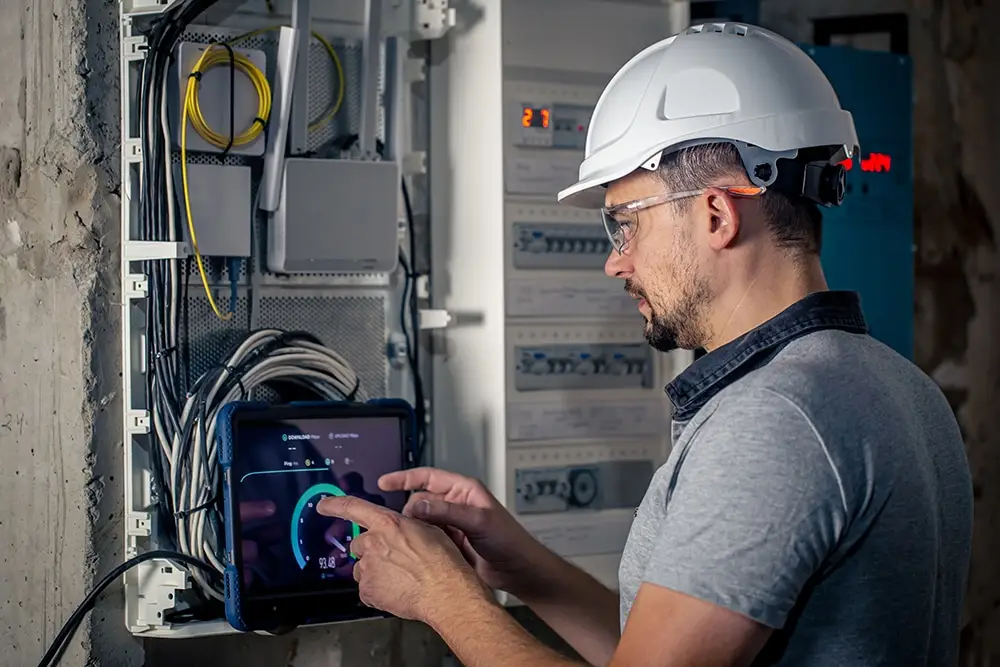The digital landscape is continually evolving, and HVAC businesses must adapt to stay competitive. One crucial aspect of staying ahead is having a well-designed and optimized website that attracts potential customers and converts them into loyal clients. In this blog post, we will guide you through the top HVAC website design strategies for 2023, covering essential elements such as user experience, visual design, functional considerations, content strategy, SEO best practices, and more. By implementing these strategies, your HVAC business will be better positioned to thrive in the ever-changing online world.
Key Takeaways
- Optimize your HVAC business with website design strategies, including user experience, conversion rate optimization and SEO.
- Utilize visual elements such as color schemes, typography and imagery to create a professional look.
- Implement content strategy tactics like blogging and customer testimonials for increased visibility & conversions.
The Importance of HVAC Website Design
Your HVAC website acts as your business’s online storefront, with its design significantly influencing customer attraction and retention. A visually appealing website with a user-friendly interface can make all the difference in turning casual visitors into clients. Moreover, a well-designed HVAC website can:
- Enhance user experience
- Optimize conversion rates
- Improve search engine rankings
- Ultimately lead to increased sales and brand recognition.
Hence, investing in a unique and effective HVAC website design that differentiates you from your competitors is of immense importance.
User Experience
User experience (UX) is the foundation of a successful HVAC website. A seamless and enjoyable browsing experience keeps visitors engaged and more likely to convert into customers. Factors such as responsive design, clear navigation, and visually appealing content all contribute to an excellent UX.
Focusing on these aspects ensures your website caters to your target audience’s needs and effectively highlights your HVAC services.
Conversion Rate Optimization
An HVAC website should be designed with the goal of maximizing conversions, turning visitors into customers. A vital aspect of conversion rate optimization is including clickable service icons and clear calls-to-action (CTAs) that guide visitors to take the desired actions, such as requesting a quote or scheduling a service. Strategically positioning these elements on your website can motivate visitors to engage with your business and boost conversion chances.
Search Engine Optimization
Search engine optimization (SEO) is another essential component of an HVAC website design. Boosting your website’s visibility on search engine results pages (SERPs) and driving more organic traffic is achievable by optimizing your website for search engines.. Factors such as keyword research, on-page optimization, and local SEO play a significant role in SEO success.
Implementing SEO best practices can help your HVAC website attain higher rankings in search results, thereby reaching a larger pool of potential customers.

Key Elements of a Successful HVAC Website
A successful HVAC website should incorporate several key elements that contribute to an excellent user experience and drive conversions. These elements include responsive design, clear navigation, and compelling content.
Ensuring your HVAC website is device-optimized, with easy-to-navigate menus and informative, engaging content, can help establish a robust HVAC company’s online presence that draws and retains potential customers.
Responsive Design
Responsive design is a crucial element of a successful HVAC website. With more than half of all website visitors accessing sites on smartphones, it is essential to provide a seamless user experience across all devices, including desktops, tablets, and smartphones. A responsive website automatically adjusts its layout and design to fit the screen size of the device, ensuring a consistent browsing experience for all users.
Implementing responsive design caters to your mobile audience’s needs and enhances your website’s overall performance.
Clear Navigation
Clear navigation is another essential element of a successful HVAC website. It helps visitors find the information they need quickly and easily, reducing frustration and increasing the likelihood of conversions. A well-structured navigation menu, with descriptive menu items and an uncluttered layout, ensures that users can navigate your website with ease.
Focusing on clear navigation enhances user experience and encourages visitors to further explore your website.
Compelling Content
Compelling content is the backbone of an effective HVAC website. It should include informative blog posts, detailed service descriptions, and customer testimonials that showcase your expertise and credibility in the industry. Providing valuable information and engaging content positions your HVAC company as a trusted authority, encouraging visitors to learn more about your services.
High-quality content also improves your website’s SEO performance, resulting in increased organic traffic and potential customers.

Visual Design Tips for HVAC Websites
Creating an appealing and professional-looking HVAC website involves paying attention to visual design elements, such as color schemes, typography, and imagery. By selecting appropriate colors, fonts, and images that align with your brand and evoke a sense of trust and professionalism, you can create a visually appealing website that reflects your HVAC company’s identity and entices potential customers.
Color Schemes
Color schemes play a significant role in setting the tone and mood of your HVAC website. It’s important to choose colors that are consistent with your brand and evoke a sense of trust and professionalism. Colors such as blue, gray, and classic combinations like black and white or navy and gold are often associated with trust and professionalism.
Selecting the right color scheme aids in creating a visually appealing website that reflects your HVAC company positively.
Typography
Typography is another essential visual design element for an HVAC website. The fonts you choose should be easy to read and visually appealing, ensuring that visitors can quickly scan and understand your website’s content. Popular font choices for HVAC websites include:
- Futura
- Bauhaus
- Neutra
- Bodoni
- Gotham
- Butler
- Consolas
- Helvetica
These fonts offer a clean, modern look that can enhance the user experience and make your website more visually attractive.
Imagery
High-quality imagery can add visual interest to your HVAC website and help humanize your company. Including photos of completed projects, team members, and other relevant images can create a sense of trust and professionalism. When selecting images for your website, ensure they are high-resolution, relevant to your services, and consistent with your brand’s image.
Incorporating visually appealing imagery results in a more engaging and attractive online presence.
Functional Design Considerations
In addition to visual design elements, functional design considerations are also crucial in creating an effective HVAC website. These include optimizing site speed, incorporating contact forms and calls-to-action (CTAs), and ensuring mobile optimization.
Focusing on these functional design aspects ensures a seamless browsing experience on all devices and motivates visitors to explore your website further.
Site Speed
Site speed is crucial for retaining visitors and improving search engine rankings. Studies suggest that over half of all web users abandon a site if it takes more than 3 seconds to load. This confirms the importance of having a fast and reliable website. To optimize your HVAC website’s speed, minimize HTTP requests, compress images, and enhance website loading speed.
Ensuring a fast-loading website enhances user experience and boosts the chances of converting visitors into customers.
Contact Forms and CTAs
Contact forms and CTAs play a significant role in driving conversions on your HVAC website. By prominently displaying contact forms and CTAs throughout your website, you encourage visitors to take action, such as scheduling a service or requesting a quote. To create effective CTAs, use action-oriented language, clearly communicate the value of taking the desired action, and create a sense of urgency.
Strategically positioning these elements on your website can enhance conversion chances and generate more leads for your HVAC business.
Mobile Optimization
Mobile optimization ensures that your HVAC website functions well on smartphones and tablets, providing a consistent user experience across all devices. With the increasing number of users accessing the internet via mobile devices, it’s essential to optimize your website for mobile use. This includes implementing responsive design, simplifying navigation menus, and optimizing elements such as buttons and images for mobile use.
Focusing on mobile optimization caters to the needs of your mobile audience and boosts your website’s overall performance.

Content Strategy for HVAC Websites
An effective content strategy for HVAC websites should include regular blogging, detailed service pages, and showcasing customer testimonials and reviews. By providing valuable information and engaging content, you can position your HVAC company as an industry expert and attract more potential customers.
Moreover, a well-planned content strategy can boost your website’s SEO performance, driving more organic traffic and potential customers to your website.
Blogging
Blogging is an excellent way to establish your HVAC company as an industry expert and provide valuable information to potential customers. By regularly updating your blog with informative articles on topics such as heat pumps, inverter technology, and indoor air quality, you can educate your audience and showcase your expertise in the HVAC industry.
High-quality blog posts can also enhance your website’s search engine rankings, attracting more organic traffic and potential customers.
Service Pages
Service pages play a crucial role in helping visitors understand the benefits and features of your HVAC services. By providing detailed descriptions of your offerings, you can effectively showcase your expertise and the value you provide to customers. Additionally, well-crafted service pages can improve your website’s SEO performance, driving more organic traffic and potential customers to your site through your exceptional HVAC service.
Testimonials and Reviews
Customer testimonials and reviews are invaluable in establishing trust and credibility for your HVAC company. By showcasing positive feedback from satisfied clients, you can encourage potential customers to choose your company for their heating and cooling needs. To collect testimonials and reviews, consider requesting feedback directly from clients or utilizing online review platforms.
Prominently displaying these endorsements on your website can help increase conversions and draw new clients.
SEO Best Practices for HVAC Websites
To improve your HVAC website’s search engine rankings and drive organic traffic, it’s essential to implement SEO best practices. These include conducting thorough keyword research, optimizing on-page elements, and focusing on local SEO.
Adhering to these best practices ensures your website ranks higher in search results, reaching more potential customers.
Keyword Research
Keyword research is the foundation of SEO and helps to identify the most relevant and high-traffic search terms for your HVAC company. By optimizing your website’s content for these keywords, you can improve your search engine rankings and attract more organic traffic.
Tools such as Google Keyword Planner or SEMrush can help you identify pertinent keywords, enabling you to adjust your website content to match these search terms and increase your chances of appearing in relevant search results.
On-Page Optimization
On-page optimization involves strategically incorporating relevant keywords into your website’s content, meta tags, and headings. This can improve your search engine rankings and help attract more potential customers.
To optimize your website for on-page SEO, focus on the following:
- Place target keywords naturally throughout your content, headers, URLs, and meta tags.
- Implement on-page optimization techniques to enhance your website’s visibility.
- Increase organic traffic to your website.
By following these steps, you can improve your website’s on-page SEO and attract more visitors.
Local SEO
Local SEO focuses on optimizing your HVAC website for local search results, helping your company rank higher in searches for HVAC services in your specific geographic area. By targeting location-specific keywords and optimizing your Google My Business listing, you can improve your local search rankings and attract more potential customers in your service area.
Local SEO is particularly important for hvac companies, as customers often search for heating and cooling contractors, including hvac contractors, near their location.

Measuring HVAC Website Performance
Measuring the performance of your HVAC website is essential for making data-driven decisions and optimizing its effectiveness. Tools like Google Analytics can help you track key performance indicators (KPIs), such as organic traffic, bounce rate, and conversion rate. By monitoring these metrics, you can identify areas for improvement and make adjustments to your website design and content strategy.
Regular performance tracking of your website can aid in optimizing its overall effectiveness, driving more leads and conversions for your HVAC business.
Google Analytics
Google Analytics is a potent instrument that offers crucial insights into website traffic patterns, user engagement, and conversion metrics. By tracking these metrics, you can identify areas for improvement and make data-driven decisions to optimize your HVAC website’s performance.
To get started with Google Analytics, follow these steps:
- Set up a free account.
- Install the tracking code on your website.
- Once installed, you can access a wealth of data and reports.
- Use this data to assess the effectiveness of your HVAC website and make informed decisions for optimization.
KPI Tracking
KPI tracking is an essential component of measuring the success of your HVAC website. By monitoring key metrics such as organic traffic, bounce rate, and conversion rate, you can assess the effectiveness of your website and make data-driven decisions to optimize its performance. Regular KPI tracking can help you identify areas for improvement, such as user experience, content strategy, and SEO tactics.
By focusing on these areas, you can make adjustments that drive more leads and conversions for your HVAC business, including air conditioning services.
Choosing the Right Platform and Tools
Selecting the right platform and tools for your HVAC website is crucial for creating a visually appealing, functional, and SEO-friendly site. Content management systems like WordPress or Wix provide a user-friendly interface for creating and managing website content, while design tools such as Adobe Creative Suite or Canva can help you create professional-looking graphics and imagery.
Choosing the appropriate platform and tools ensures your HVAC website meets your company’s needs and promotes conversions.
Content Management Systems
Content management systems (CMS) like WordPress or Wix offer a user-friendly platform for creating and managing website content. With a CMS, you can easily update your HVAC website with new blog posts, service pages, and customer testimonials, ensuring that your online presence remains current and relevant.
Additionally, a CMS enables you to optimize your website for mobile devices, improve user experience, and integrate social media platforms for a stronger online presence. By selecting the right CMS for your HVAC website, you can streamline the content management process and maintain an effective online presence.
Design Tools
Design tools like Adobe Creative Suite or Canva can help you create professional-looking graphics and imagery for your HVAC website. These tools offer a wide range of features and capabilities for designing visually engaging content, editing images, and laying out website content. Additionally, utilizing HVAC website templates can further streamline the design process.
By leveraging these design tools, you can craft custom graphics, optimize images, and design the layout of your website to effectively promote your services and draw in potential customers.

Hiring a Professional HVAC Website Designer
Hiring a professional HVAC website designer can ensure a high-quality, optimized website that meets your company’s needs and drives conversions. A professional designer will have the expertise and experience to:
- Create a visually appealing website
- Develop a functional website
- Design an SEO-friendly website
- Generate leads
- Help your HVAC company grow
Investing in professional web design services ensures your website is expertly designed to highlight your services, engage potential customers, and drive more business.
Summary
In conclusion, optimizing your HVAC website is essential for staying competitive in the digital landscape. By focusing on user experience, visual design, functional design, content strategy, and SEO best practices, you can create a website that attracts potential customers and generates leads. Remember to measure your website’s performance regularly and make data-driven decisions to continually improve its effectiveness. With the right strategies in place, your HVAC website can become a powerful tool for growing your business and establishing your company as an industry leader.
Frequently Asked Questions
What is a HVAC website?
HVAC websites are a great way to connect with customers, showcase your services and promote yourself online. They allow potential customers to learn more about your business, book services and find you quickly.
What are the four 4 main types of HVAC systems?
HVAC systems can be divided into four categories; Split Systems, Package Units, Hybrid and Ductless. Each of these systems come in different sizes and specifications that fit your home or business needs.
What is HVAC design?
HVAC design is a subdiscipline of mechanical engineering that focuses on the principles of thermodynamics, fluid mechanics and heat transfer in order to design efficient heating, cooling and ventilation systems. It is typically undertaken by consulting or design companies, or design and build contractors.
What is the basic knowledge of HVAC system?
HVAC systems circulate air by transferring hot and cold air through a system of ducts, with mechanical ventilation for air circulation and air quality maintenance.
What is the importance of responsive design for HVAC websites?
Responsive design is essential for HVAC websites to ensure that users have a consistent experience across all devices, from desktops to smartphones.






